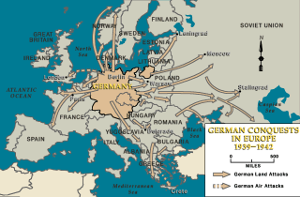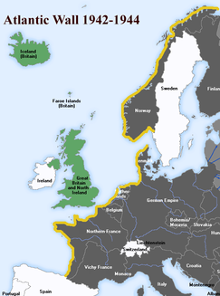The D-Day invasion, as the June 6, 1944, landings at the French beaches of Normandy have become known, were a momentous set of events that turned the tide of World War II in Europe. The result of meticulous and ultra-secret planning, the invasion was far from a sure thing and nearly didn't happen at all. It cost thousands of lives and even more money and equipment, but it did hasten the end of the Germany's Fortress Europe. 
The German armed occupation of Europe during World War II began on September 1, 1939, when German boots, tanks, and planes rolled into Poland. With that country quickly defeated, German forces continued their lightning attacks, seizing Denmark and Norway in April 1940. The very next month, Germany forced the surrender of Belgium, Luxembourg, and the Netherlands. In June, German troops occupied Paris, forcing the surrender of France. Germany added Greece and Yugoslavia to the fold in April 1941, and that was the way things stayed in Western Europe for a time because Germany invaded the Soviet Union on June 22. Germany had tried to soften up the United Kingdom, with wave after wave of bombings, as a prelude to an invasion. The U.K. won the Battle of Britain, however, and German leader Adolf Hitler called off the invasion. The German invasion of the Soviet Union made an enemy of that country, and the Japanese attack on Pearl Harbor later that same year made the United States an enemy. Soon, an alliance of the Soviet Union, the U.S., and the U.K. were coordinating battle plans. Planning
It was rough going at first, but Allied manpower eventually turned back the Axis presence in the Mediterranean region, first in North Africa and then in Italy. At the same time, Allied ships were making the Atlantic a safer place for Allied shipping and troop transports. What wasn't possible in the early part of the war was now more of a possibility. Planning turned to an invasion of France. 
Beginning in 1942, Germany had impressed nearly a million French workers into building a large system of coastal fortifications along the Atlantic coastline of France, especially, but also Belgium, Denmark, Norway, and the Netherlands. The more than 1,500 miles of fortifications took the form of walls, fences, and were punctuated by deadly means of defense such as guns, artillery, and mortars. Overseeing the construction of the Atlantic Wall and its defense were thousands of German troops. Patrolling the Atlantic were a large number of German ships as well. Because of the early success of the German navy in patrolling the Atlantic, Allied attacks targeting the Atlantic Wall were few and far between in the first few years of its existence. As the tide turned more and more in the Allies' favor, German forces prepared for an Allied invasion of Europe. The German high command assigned first Field Marshal Gerd von Rundstedt and then Rommel to reinforce the defenses. Next page > Finding the Right Spot > Page 1, 2, 3, 4, 5 |
|
Social Studies for Kids
copyright 2002–2026
David White




